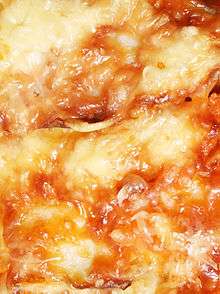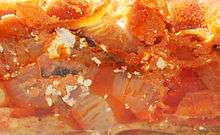Kalliopi (food)

Kalliopi (/kəˈlaɪ.əpiː/ kə-LY-ə-pee; Greek spelling: Καλλιόπη) is a vegetable-based dish from Attica in Greece. The age of the recipe is hard to determine, since the original date of introduction is merely based upon rumors. One can almost be certain however, that the first kalliopi was created recently, because it is hard to find any documentation on a dish named kalliopi before the turn of the century. The ingredients are mostly vegetables and there are no reported versions of kalliopi that contain meat of any kind. Due to its long preparation time, kalliopi will generally only be eaten on special occasions. It is said to be best served warm and eaten with feta and bread.
History

Rumor has it that kalliopi was invented by a chef in Athens. Supposedly he was preparing a dish and had to improvise with the ingredients because he was running low on stock at his apartment. He chose to prepare something new, since he could not make an existing dish with the combination of the ingredients that he did have. He made the first kalliopi while his girlfriend was sleeping and ended up naming the dish after his girlfriend: Kalliopi.[1] In some versions of the story it is said that he was preparing this dish with the lights off and used a lighter to navigate through the kitchen, because there were no walls separating the kitchen from the bedroom and he preferred not to wake up his girlfriend. In other versions of the story the lights were on or nothing is mentioned about the lights, but due to the first recited version of the story this dish is sometimes also referred to as Kalliopi in the dark (or Καλλιόπη στο σκοτάδι in Greek).
Recipe
There are noted variations of kalliopi and some argue that the dish is best served hot, while others have a clear preference to eat it cold. There is not necessarily one way to prepare a kalliopi, but commonly the list of ingredients is the same throughout the whole of Greece. Abroad it is sometimes prepared differently and frequently the feta or the Ouzo are replaced with goat cheese or ricotta and wine, since they are more common outside of Greece. According to sources,[2] the most popular way to prepare kalliopi is as follows:

Ingredients
- 2 Egg plants (Aubergines)
- 5 or 6 medium sized potatoes
- 2 large onions
- 3 large tomatoes (or one can of chopped tomatoes and some tomato paste)
- 3 to 4 large cloves of garlic
- 200 grams of feta
- 200 grams of grated cheese
- 50 ml of Ouzo
- 2 to 3 eggs (optional)
- a few pieces of toast
- nutmeg
- salt and pepper
- olive oil
Preparation
Phase one - preparation of the hard vegetables
Step 1: Wash the egg plants and chop them into small cubical pieces leaving the top and the bottom
Step 2: Bath the egg plant pieces in salt water for fifteen to forty minutes (preferably in boiling or hot water)
Step 3: Wash the potatoes and cut them in half. Boil the potatoes with the skin

Phase two - making the sauce
Step 4: Preheat the oven at 370 degrees (190 degrees Celsius)
Step 5: Bake the egg plant pieces in a large pan with some oil. Cut onions into medium sized pieces. Add nutmeg, salt and pepper to the egg plants
Step 6: Add the onions to the egg plants when the pieces are starting to become soft. Cut the garlic into thin slices
Step 7: Add the garlic to the pan and cut the tomatoes into small pieces (unless you are not using fresh tomatoes)
Step 8: Add the tomatoes (or a can of chopped tomatoes and some tomato paste) to the sauce and shortly after add the Ouzo (it can be more or less than the amount mentioned above and can also be replaced with wine)
Step 9: Let the sauce thicken, but do not let it get too thick (it still needs to be easy to stir)
Phase three - assembling the kalliopi
Step 10: Put some oil in a baking tin and cut the potatoes into thin slices. Put a layer of potatoes at the bottom of the tin
Step 11: Put some salt on the previous layer and add a layer of sauce to the tin
Step 12: Add a layer of potatoes and again, add some salt
Step 13: Add another layer of sauce topped with a layer of bread crumbs created by rubbing the pieces of toast together
Step 14: Add a layer of potatoes and cover with feta
Step 15: Add a layer of sauce and add some salt to it. Top it with a layer of potatoes
Step 16: Put the cheese on top and some additional salt and/or pepper and poor some oil onto the kalliopi
Step 17: Put the tin in the oven for about forty minutes to an hour
Superstition
No matter how you prepare kalliopi, it is generally a dish that consists of a high number of actions. This number ordinarily exceeds the number thirteen. Some people skip step 13 due to superstition, but often it is considered an indispensable step.[3]
Kalliopi alternatives
In urban areas (most notably Athens) kalliopi is sometimes prepared with an extra layer of egg. These eggs are added to the layer of bread crumbs, but it is also not unusual to add the eggs to the layer of feta or to one of the potato layers. However, the eggs are never added to a sauce layer, since this will change the substance of the kalliopi entirely.

Sometimes parsley is added to kalliopi (in the sauce or in the general assembly) to add some freshness to the dish. Once ready, the dish will then be eaten with lemon juice.
According to personal preference, the potatoes in the kalliopi can be fried or baked before they are put inside the baking tin. The kalliopi will become more crunchy when one chooses to use fried potatoes.
Tips
The layers should not be too thin. It is advised to rather use a smaller baking tin than thinner layers. Commonly the layers are approximately a finger width thick (about 1 cm).
References
- ↑ http://www.reddit.com/r/food/comments/ryp4u/cottage_piewe_called_it_hamburger_pie/
- ↑ http://allrecipes.com/personalrecipe/63177213/kalliopi/detail.aspx
- ↑ http://www.reddit.com/r/food/comments/rz43i/stupidity/